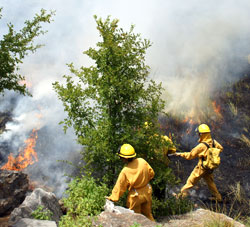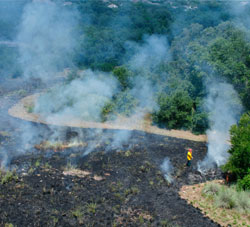Trial by Fire
SCORCHING TEMPERATURES THIS PAST AUGUST didn’t deter the Wildflower Center’s prescribed burn team from setting ablaze 11 acres of the Savanna Meadow. Armed with drip torches, they conducted a prescribed fire to promote spring wildflower growth in the meadow viewed by many visitors and to clear brush that can fuel potential wildfires.
The Lady Bird Johnson Wildflower Center uses about 70 acres of land to research how fire stacks up to herbicides and other approaches to managing unwanted vegetation on large landscapes. Dr. Mark Simmons, director of research and consulting, and other staff are in the 10th year of a long-term project comparing various management practices including frequent mowing and prescribed fire.
 As part of the research, Wildflower Center staff conduct prescribed fires during the fall, winter and summer. The goal is to see how non-native, sometimes invasive plants fare in comparison to natives adapted to wildfires that used to burn uncontrolled after lightning storms in Texas.
As part of the research, Wildflower Center staff conduct prescribed fires during the fall, winter and summer. The goal is to see how non-native, sometimes invasive plants fare in comparison to natives adapted to wildfires that used to burn uncontrolled after lightning storms in Texas.
A prescribed fire is conducted by a certified experts to influence vegetation features of a landscape. Detailed planning as well as proper weather conditions are essential to the process, with staff monitoring weather forecasts up to and during the fire. Wind direction, for example, must stay relatively consistent so that the fire carries into areas that have already been cleared of flammable vegetation — called a fire break. National Weather Service information is also used to ensure that smoke from the fire is dispersed as fast as possible.
During the 3-hour prescribed burn in August, an Austin Fire Department truck stood at the ready beside Center vehicles, some Center staff carried water sprayers to limit the fire’s spread, and a team member continually surveyed nearby woods to check for embers that an errant wind might have carried aloft. This surveying and ‘mop-up’ of the burned area continued well into the night and for several days after.
After the burn, Wildflower Center staff members blanketed the charred grass just outside the Visitors Gallery with a Native American Seed mix of Indian paintbrush, Texas yellow star, Texas bluebonnet and more. Much of the land changed to green growth within a month thanks to favorable weather. About 80 percent of the response of native plants in recovering from fire is rain related. “It’s always the rainfall that really holds the key,” Simmons says.

The majority of Central Texas, which historically had large areas of grassland and savanna, is now woodland, dominated by Ashe juniper (the “cedar” of cedar fever fame) and live oak. The August burn was a reminder that fire is an excellent tool to help return prairie or savanna to their more biologically diverse origin. These burns prevent woody growth from dominating other species and help keep invasive species in check.
Using fire as a land management tool has other benefits. Prescribed fires cost less than herbicides, large-scale mowing or mechanical removal of brush. They are also better for the environment because they do not leave harmful toxins in the earth or excessively compact soils. Although someone may have to conduct additional prescribed fires to eradicate stubborn invasive species, Center staff note that the approach is still better than relying solely on herbicides or mechanical removal.
“Fire is a much more sustainable tool because you’re not delivering herbicide repeatedly over time onto the landscape and building up toxins that ultimately will have a negative impact,” says John Hart Asher, environmental designer at the Wildflower Center.
Landscape steward Michelle Bertelsen adds, “To keep fire-adapted landscapes such as savanna healthy you have to replace wildfire, either with prescribed fire or by doing physical clearing or using herbicides. So what we’re doing is just putting back a natural part of these landscapes, which is fire.”

